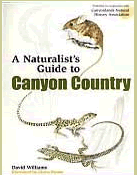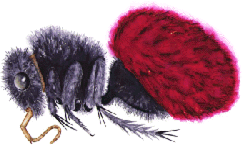A Naturalist's Guide to Canyon Country
160
pp., 6x9", maps,
color illustrations $22.95
Published by Globe Pequot Press
ISBN 1-56044-783-4

A comprehensive guide to the geology, shrubs, trees, flowers,
mammals, birds, fish, reptiles, amphibians, insects, and arachnids of
the northern Colorado Plateau (encompasses eastern Utah, far western
Colorado, and sections of northern Arizona and New Mexico). First-time
visitors and seasoned desert rats will appreciate this well-organized
guide with over 250 species identified. Includes over 200 black-and-white
and color drawings by Gloria Brown.
"Wandering through bookstores from Moab to Zion,
we kept stumbling across this beautifully illustrated, highly informative
book on red rock country. A Naturalist’s
Guide to Canyon Country is
an indispensable component of any Southwest trip."
Best of 2006 - Gear and Trends - Desert
National Geographic Adventure - December 2005/January 2006
"When
I am hiking in the desert I will take four items with me: food, water,
a map,
and this field guide.
David Williams' book is that essential and that critical to a desert
lover's experience."
Terry Tempest Williams
Author of Refuge and Coyote's Canyon
“Can you distinguish Cedar Mesa Sandstone from Wingate Sandstone? Find
a hanging garden? Track a river otter? From Douglas fir to darkling beetle,
and cryptobiotic soil crust to coyote, "A Naturalist’s Guide to
Canyon Country" reveals the intricacies of nature in these slickrock landscapes.
Whether you are a long-time resident or a first-time visitor, this engagingly
written and beautifully illustrated book is a must.”
Susan J. Tweit
Author of The Great Southwest Nature Factbook
Canyon treefrog Hyla
arenicolor
1 1/4 to 2 inches, prominent toe pads, skin color matches surroundings with
scattered small, darker splotches
Canyon treefrogs depend upon camouflage to protect themselves from predators.
They blend in so well that you can overlook them even when staring directly
at them. These small batrachians rarely venture far from water during the day
and usually sit motionless in cracks, under boulders or behind vegetation.
They are active at night, sometimes traveling up to 200 feet from water. Breeding
occurs from March to July and eggs are laid singly in quiet water. The tadpoles,
which can grow to two inches, metamorphose in six to ten weeks.
Similar to most desert toads and frogs, canyon treefrogs can tolerate high temperatures and severe desiccation. A warmer body offers several benefits including increased rates of food digestion, protection against bacterial infection, and control of external parasites. Dehydration also helps control parasites. Blood sucking mites, which live on treefrogs, will leave the surface of a desiccated frog. Drawing by Gloria Brown

Velvet ant Dasymutilla
spp.
1/2 to 1 inch long, females wingless, densely covered with orange, red, or
yellow hairs
Most of us have been warned to not judge a book by its cover. One should not
judge insects that way either. Velvet ants look like hairy, extravagantly-colored
ants, which might be fun to pick up. Do not be fooled. They are actually wasps
that have a particularly painful sting; one common name is "cow-killer." The
orange, yellow, or red wingless females, which are encountered more often than
the winged-males, are often seen scurrying across the ground. She is probably
searching for other ground nesting wasps or bees, where she can deposit her
eggs. When they hatch, the larva will consume their host before pupating into
an adult. The females emit a peculiar squeaking when their body is pinched
lightly. Needless to say, don't try this with your bare hands. Drawing by
Gloria Brown
The fourth printing, which came out in January
2006, fixed several errors in the book, including the following.
Pg. 81-82 - The western pipistrelle bat illustration
and the pallid bat illustration need to be switched. The bat eating the scorpion
is the pallid bat.
Pg. 146 -147 - The side-blotched and the
tree lizard drawings need to be switched. The lizard with the blue dot behind
its
right leg is the side-blotched lizard.
But a few errors remain, mostly due to changes in
naming of plants and animals and dating of geologic time periods. Here they
are.
pg. 7 – change “570” to “542”
pg. 7 – change “570-320 MYA” to “542-318 MYA”
pg. 11 – change “286-245 MYA” to “299-251 MYA”
pg. 12 – change “245-208 MYA” to “251-200 MYA”
pg. 13 – change "along U.S. Highway 191" to "along
Utah SR-128”
pg. 13 – change “208-144 MYA” to “200-145 MYA”
pg. 17 – change “104-66 MYA” to “145-65 MYA”
pg. 18 – change “66-2 MYA” to “65-1.8 MYA”
pg. 18 – change “2 MYA” to “1.8 MYA”
pg. 31 – change “Salsola pestifer” to “Salsola
tragus”
pg. 49 –change “120 million years ago” to “130
million years ago”
pg. 57 – change “Plains prickly pear” to “Central
prickly pear”
pg. 58 – change “Plains prickly pear” to “Central
prickly pear”
pg. 60 – change “banana” to “datil”
pg. 62 – the same change needs to be made twice – change “dwarf
evening primrose” to “tufted evening primrose”
pg. 63 – last paragraph after “another datura species” please
add “(D. stramonium)”
pg. 67 – “mollismus” is misspelled it should be “mollissimus”
pg. 69 - under common globemallow please change “Nelson’s
globemallow” to “small-leaf globemallow”
pg. 70 – change “Gilia aggregata” to “Ipomopsis
aggregata”
pg. 71 – change “annual” to “Eastwood’s” and “Wyoming” to “linearleaf”
pg. 83 – change “Eutamias” to “Tamias”
pg. 86 – change “Cynomys utahensis” to “Cynomys
parvidens”
pg. 89, 90, 91, 92, 93 – Change the family name “Cricetidae” to “Muridae” for
all species on these pages.
pg. 96 – change family name of western spotted skunk from “Mustelidae” to “Mephitidae”
pg. 98 – Change “Felis” to “Puma”
pg. 99 – Change “Felis” to “Lynx”
pg. 110 - change “Goshawk” to “Northern Goshawk”
pg. 114 – change “Pica pica” to “Pica hudsonii”
pg. 116 – change “Guiraea caerulea” to “Passerina
caerulea”
pg. 123 – change “Chonolestes” to “Chondestes”
pg. 127 – change “Hirundo” to “Petrochelidon”
pg 130 – change “Otus” to “Megascops”
pg. 131 – change “Baeolophus griseus” to “Baeolophus
ridgwayi”
pg. 145 – eliminate “cephalaflavus” from the scientific
name of Desert spiny lizard
pg. 145 – new common name is “Northern Plateau Lizard” and
new scientific name is “Sceloporus tristichus”
pg. 147 – new common name is “Mountain Short-Horned Lizard”
pg. 151 – change Family name of two garter snakes from “Colubridae” to “Natricidae”
pg. 154 –change species name of Great Plains Rat Snake from “Elaphe
guttata emoryi” to “Elaphe emoryi”
pg. 154 – change family name of Night Snake from “Colubridae” to “Dipsadidae”
pg. 155 – change “Crotalus viridis concolor” to “Crotalus
oreganus concolor”
pg. 155 – change “Crotalus viridis lutosus” to “Crotalus
oreganus lutosus”
pg. 155 – change family name of rattlesnakes from “Viperidae” to “Crotalidae”
pg. 159 – change family name of Great Basin Spadefoot Toad from “Pelobatidae” to “Scaphiopodidae”
pg. 162 – change family name of Tiger Salamander from “Ambystomidae” to “Ambystomatidae”
pg. 170 – change “Stenohelmatus” to “Stenopelmatus”
pg. 170 - under darkling beetle, change Tenobrionidae to Tenebrionidae.
In addition, change the opening sentence to read. "Darkling beetle
is a common name given to many beetle species in the family Tenebrionidae
in the United States. The majority are in the west. The most common ones
in this area are in the genus Eleodes and are also known as pinacate
beetles."
Updates and Improvements
Pg. 172 - Here is a list of the names of
some of the species shown in the potholes drawing.
Tadpole shrimp - Triops longicaudatus
Backswimmer - Notonecta sp.
Predaceous diving beetle - Eretes sticticus
Chironomid (midgefly larvae) - Family Chironomidae
Clam shrimp - Order Conchostraca
Fairy shrimp - Branchinecta packardi (colder weather) and Streptocephalus
texanus (warmer weather)
Rotifer - Class Bdelloida
Tardigrade (water bears) - Class Tardigrada
Ostracod (seed shrimp) - Class Ostracoda